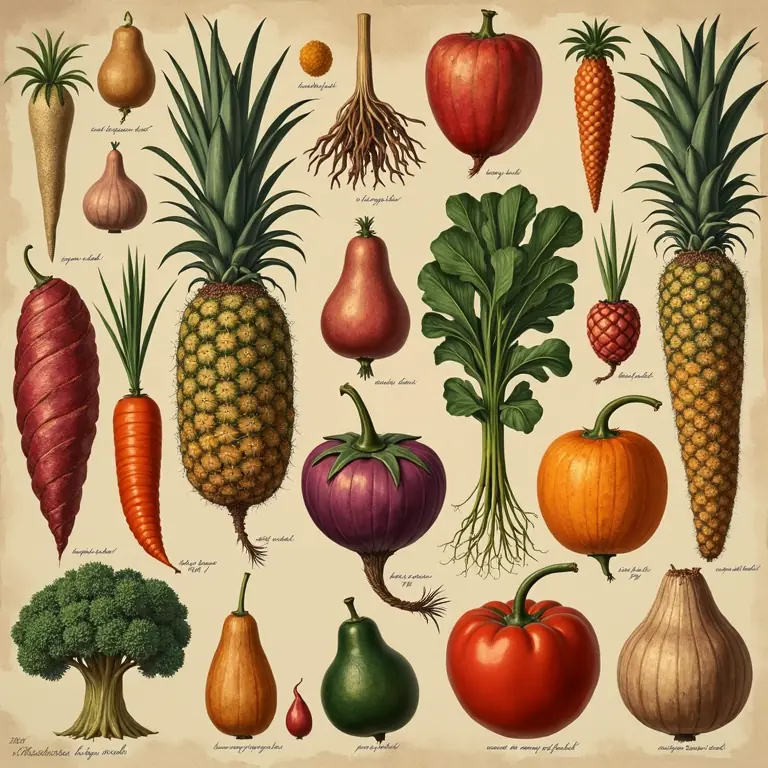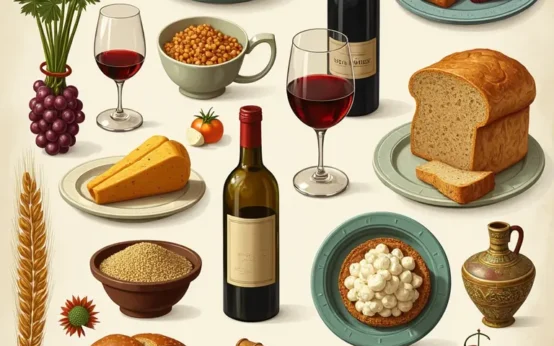We often take for granted the foods we eat every day. That crisp apple, that comforting bowl of pasta, the humble potato – they seem to have always been with us. But every food has a history, a journey from its wild origins to our plates. And that journey is often far more surprising, complex, and fascinating than you might imagine. This article delves into the unexpected origins of some common foods, revealing the cultural exchanges, accidental discoveries, and surprising twists of fate that brought them to your table.
The Apple: From Kazakhstan to Your Lunchbox
The image of a rosy apple often evokes idyllic orchards and American traditions. However, the apple’s story begins not in America, but in the mountains of Kazakhstan, in Central Asia. Malus sieversii, considered the wild ancestor of the modern apple, still grows there today. These apples were small, tart, and often crab-like. As the Silk Road flourished, apples traveled westward, encountering other Malus species along the way. Roman soldiers, known for their horticultural skills, spread apples throughout Europe.
The apples we know today are the result of centuries of selective breeding. Johnny Appleseed, a legendary figure in American folklore, didn’t actually plant apple trees for eating. He spread apple seeds to make hard cider, the popular alcoholic beverage of the time. The diversity of apple varieties – from the tart Granny Smith to the sweet Honeycrisp – is a testament to the ongoing human influence on this fruit’s evolution.
Chocolate: A Bitter Beginning
Chocolate, a globally beloved treat, has a surprisingly bitter origin. Its story begins with the cacao tree, native to the rainforests of Mesoamerica. The Olmec civilization, around 1500 BCE, were among the first to cultivate cacao, but it wasn’t the sweet confection we know today. They created a bitter, frothy drink flavored with spices like chili peppers, vanilla, and achiote. This drink, called xocolatl, was reserved for the elite and used in religious ceremonies.
The Mayans and Aztecs continued this tradition, valuing cacao beans as currency and a sacred beverage. When the Spanish conquistadors arrived in the 16th century, they encountered xocolatl and initially found it unpalatable. However, they eventually began adding sugar, honey, and other sweeteners, transforming it into a drink more appealing to European tastes. It took several centuries for chocolate to become the solid, sweet treat we enjoy today, with the invention of the cocoa press and the development of milk chocolate in the 19th century.
Potatoes: From the Andes to Global Staple
The humble potato, now a cornerstone of diets worldwide, originated in the Andes Mountains of South America, in present-day Peru and Bolivia. For millennia, indigenous populations cultivated potatoes, developing thousands of varieties adapted to different altitudes and climates. They were a vital food source, providing sustenance and playing a role in their culture and religion.
Spanish conquistadors brought potatoes to Europe in the 16th century, but their adoption was slow. Europeans were initially suspicious of this strange new root vegetable. It was often grown as an ornamental plant before its culinary potential was realized. The potato’s breakthrough came in Ireland, where it thrived in the cool, moist climate and became a staple food for the poor. However, the devastating Irish Potato Famine of the mid-19th century, caused by a potato blight, tragically demonstrated the dangers of relying on a single crop. Today, potatoes are the world’s fourth-largest food crop, after rice, wheat, and maize.
Pasta: More Than Just Italian
While Italy is synonymous with pasta, its origins are more complex. The earliest forms of pasta likely originated in Asia. Archaeological evidence suggests that noodle-like foods were consumed in China as early as 4,000 years ago. Marco Polo is often credited with bringing pasta to Italy from China in the 13th century, but this is largely a myth. Trade routes and cultural exchanges between the Middle East and Sicily likely played a more significant role in introducing dried pasta to Italy.
The Arabs, who controlled Sicily for several centuries, introduced dried pasta, called itriyya, which was well-suited to the Mediterranean climate and long storage. Over time, Italian cooks adapted and refined pasta-making techniques, creating a vast array of shapes and sauces. The industrialization of pasta production in the 19th century made it accessible to a wider population, solidifying its place as a global culinary staple.
Tomatoes: From Aztec Gardens to Pizza Toppings
The vibrant tomato, now a cornerstone of Italian cuisine and countless other dishes, has a surprising past. Originating in the Andes region of South America, tomatoes were first cultivated by the Aztecs in Mexico. They called it xitomatl, and it was used in sauces and stews.
When the Spanish brought tomatoes to Europe in the 16th century, they were initially viewed with suspicion. Many Europeans believed they were poisonous, due to their relation to other poisonous plants in the nightshade family. It took centuries for tomatoes to gain acceptance as a food source. They were first cultivated as ornamental plants, and it wasn’t until the 18th and 19th centuries that they became a popular ingredient in Italian cuisine, particularly in Naples, where they were combined with pasta to create the iconic pizza.
Coffee: A Journey from Ethiopia
The invigorating aroma of coffee is familiar worldwide, but its story begins in the highlands of Ethiopia. Legend has it that a goat herder named Kaldi noticed his goats becoming unusually energetic after eating the berries of a certain tree. He tried the berries himself and experienced a similar stimulating effect. This marked the discovery of coffee’s energizing properties.
From Ethiopia, coffee traveled to Yemen, where it was cultivated and brewed into a beverage. Coffee houses, called qahveh khaneh, became centers of social and intellectual life in the Arab world. By the 17th century, coffee had reached Europe, where it faced initial resistance from some who considered it a “bitter invention of Satan.” However, coffee houses quickly gained popularity, becoming hubs for discussion and debate. Today, coffee is one of the most traded commodities in the world.
Sugar: A Sweet but Troubled History
Sugar, a seemingly simple sweetener, has a complex and often brutal history. Its origins lie in Southeast Asia, where sugarcane was first cultivated thousands of years ago. The process of extracting sugar from sugarcane was refined over centuries, and it became a valuable commodity traded throughout the ancient world.
The spread of sugar cultivation to the Americas in the 15th and 16th centuries was fueled by the transatlantic slave trade. Large-scale sugarcane plantations, particularly in the Caribbean, relied on the forced labor of enslaved Africans. The demand for sugar grew exponentially as it became more affordable and accessible. While sugar makes our desserts more palatable, it’s essential to remember the dark history behind its production.

Corn (Maize): A Mesoamerican Gift
Corn, or maize, is a staple food for millions worldwide. Its story begins in Mesoamerica, in present-day Mexico, around 9,000 years ago. Indigenous people domesticated teosinte, a wild grass, through selective breeding, gradually transforming it into the corn we know today. Corn was not only a food source but also held deep cultural and religious significance for the Maya, Aztecs, and other Mesoamerican civilizations.
When Europeans arrived in the Americas, they encountered corn and recognized its potential. It was introduced to Europe and then spread to other parts of the world. Corn’s adaptability and high yield made it a valuable crop, particularly in regions with less fertile soil. Today, corn is used for a wide variety of purposes, including food, animal feed, and industrial products.
Bananas: From Southeast Asia to Global Fruit Bowl
The banana, a ubiquitous fruit in supermarkets worldwide, has a surprisingly limited genetic diversity. The most commonly consumed banana today, the Cavendish, is a clone. Its story begins in Southeast Asia, where bananas have been cultivated for thousands of years.
Early bananas were full of seeds and not particularly palatable. Through natural mutations and selective breeding, seedless varieties emerged. The Gros Michel banana was the dominant variety in the early 20th century, but it was wiped out by a fungal disease called Panama disease. The Cavendish banana, resistant to that strain of Panama disease, replaced the Gros Michel and became the world’s most popular banana. However, the Cavendish is now threatened by a new strain of Panama disease, raising concerns about the future of banana production.
Spices: The Driving Force of Exploration
Spices played a crucial role in shaping world history. For centuries, spices like pepper, cinnamon, cloves, and nutmeg were highly valued for their flavor, medicinal properties, and preservative qualities. The demand for spices drove exploration and trade, leading to the discovery of new lands and the establishment of trade routes.
The Spice Islands (present-day Indonesia) were the source of many of the most valuable spices. European powers competed fiercely for control of the spice trade, leading to conflict and colonization. Spices not only enhanced cuisine but also fueled economic and political rivalries.
Want to learn more about how cultures and languages have evolved throughout history? Check out this article on lost languages.
Citrus Fruits: A Tangy Tale
Oranges, lemons, limes, and grapefruits – citrus fruits brighten our meals and provide a boost of vitamin C. Their origins lie in Southeast Asia, where they first evolved. Citrus fruits gradually spread westward through trade routes, eventually reaching the Mediterranean region.
The Romans were among the first to cultivate citrus fruits in Europe, but their cultivation was limited by the climate. During the Middle Ages, Arab traders introduced citrus fruits to Spain and Sicily, where they thrived. From there, citrus fruits spread to other parts of Europe and eventually to the Americas. The introduction of citrus fruits had a significant impact on health and nutrition, helping to prevent scurvy among sailors.
Peanuts: A New World Native
Despite being associated with African and Asian cuisines, the peanut originated in South America, likely in Brazil or Peru. Spanish and Portuguese explorers brought peanuts to Africa and Asia in the 16th century, where they became integrated into local culinary traditions.
In North America, peanuts were initially grown as a forage crop for livestock. It wasn’t until the late 19th and early 20th centuries that they became a popular food source, thanks to the efforts of George Washington Carver, who developed hundreds of uses for peanuts, including food products, cosmetics, and industrial materials.
Tea: A Calming Brew with a Rich Past
Tea, the world’s most consumed beverage after water, originated in China, with legends tracing its discovery back to Emperor Shen Nung around 2737 BCE. Initially, tea was used for medicinal purposes, but it gradually evolved into a social beverage.
Tea spread to other parts of Asia, including Japan and Korea, where it became deeply ingrained in their cultures. European traders introduced tea to Europe in the 17th century, and it quickly gained popularity, particularly in England. The British East India Company played a significant role in the global tea trade, and the demand for tea led to the Opium Wars with China.
Beyond the Plate: The Cultural Significance of Food
The origins of these common foods reveal that our culinary landscape is a product of centuries of cultural exchange, adaptation, and innovation. Food is not just sustenance; it’s a reflection of our history, our values, and our connection to the world around us. Understanding the origins of the foods we eat can deepen our appreciation for the diversity of human cultures and the complex processes that bring food to our tables.
And just as our understanding of food history is enriched by understanding cultural beliefs, so too is it informed by the stories and symbolism attached to animals. Learn more about animal superstitions and their origins around the world.


 The Curious Chronicle of Lost Recipes: Culinary Secrets Across the Ages
The Curious Chronicle of Lost Recipes: Culinary Secrets Across the Ages  The Surprisingly Consistent Etymology of Food Names: From Origins to Our Plates
The Surprisingly Consistent Etymology of Food Names: From Origins to Our Plates